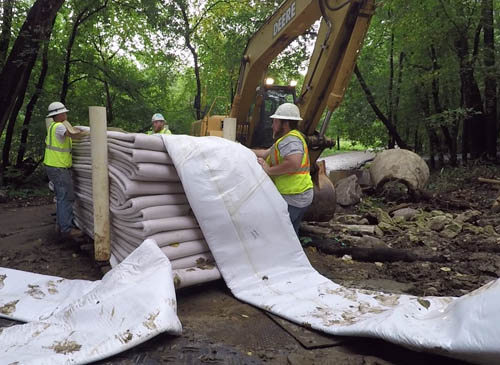“Do not disturb.” That’s a message from the U.S. Fish and Wildlife Service to human activity around active bald eagle nests.
As a result, work on the Council’s Beltline Interceptor Sewer on Saint Paul’s East Side is covered under a special federal permit for sanitary sewer construction taking place near an eagle nest. This one is perched within fishing distance of the Mississippi River.
 “We try very hard when we work on wastewater projects to minimize impacts,” said Chad Davison, an engineer and project manager for Metropolitan Council Environmental Services (MCES). “Residents, businesses, wildlife, and natural amenities are among the many considerations we take into account when working on projects like this, which help to maintain the region’s wastewater system, preserve water quality and safeguard public health.”
“We try very hard when we work on wastewater projects to minimize impacts,” said Chad Davison, an engineer and project manager for Metropolitan Council Environmental Services (MCES). “Residents, businesses, wildlife, and natural amenities are among the many considerations we take into account when working on projects like this, which help to maintain the region’s wastewater system, preserve water quality and safeguard public health.”
The protected eagle nesting period runs January through August, although most eagles begin nesting in February and finish by mid-July. To accommodate the prospect of new additions to the eagle population, MCES, working with contractors, will wait until after the 2019 nesting season to tend to some of the project work.
“For example, we will postpone removal of some of the infrastructure used to access the sewer for rehabilitation until fall 2019 rather than during the nesting period,” said Davison.
“Sewer within a sewer”: Technology lines, rather than replaces, aging pipe
The Beltline interceptor is a large sewer pipe that extends through the Payne-Phalen and Dayton’s Bluff neighborhoods of Saint Paul. The pipe ranges in size from 54 to 72 inches in diameter and does some of the heaviest lifting of the regional sewer pipes. It conveys an average of 17 million gallons of wastewater per day from 14 communities in the northeast and east metro to the big Metro Wastewater Treatment Plant in Saint Paul.
But the portion of the pipe that’s undergoing renewal was built in the late 1980s. Given the flow of wastewater through the pipe, buildup of hydrogen sulfide gas that corrodes concrete, and better capability to inspect the condition of sewers, we know sections of the pipe need a makeover.
Rather than replace the concrete pipe entirely, however, construction workers will install a liner inside the existing pipe using a technology called “cured-in-place-pipe” or “CIPP.” In the process, a felt-like liner soaked with resin is inserted into the old pipe. Hot water is pumped in to inflate the liner and cause the resin to harden. Voila: a new sewer pipe within the old, damaged sewer pipe.
No long-term closures of roads expected
“The technology is a longer-term solution, and we don’t have to dig up the existing pipe to replace it, so it’s less intrusive, less disruptive and less costly,” said Davison. “Rather, we dig in a few places to be able to access the sewer and set up temporary pumps and pipes to carry the wastewater around the construction area.”
 “This helps to minimize impacts to local residents and businesses,” said Davison, who says MCES will take additional steps to reduce disruptions.
“This helps to minimize impacts to local residents and businesses,” said Davison, who says MCES will take additional steps to reduce disruptions.
“We don’t expect long-term road closures during this project. Short-term closures of less than a week will occur near Parkway Middle School while we install the temporary pumps and pipes in the work area,” said Davison. “We expect some sidewalk closures and detours along Bush Avenue between the school and park when work is occurring. This will help keep pedestrians from crossing construction traffic.”
Beltline project is part of larger sewer improvement/investment plan
The first phase of the Beltline project occurred in 2016 and 2017 near Phalen Park. The second phase will take place at two sites using the CIPP technology: along Highway 61 south of I-94 and along Etna Street between Case Avenue and Beech Street (near Penny Park and Parkway Middle School). The project is expected to be wrapped up by July 2020.
The $10 million project is part of a 10-year, $1 billion region-wide initiative that began in 2013 to accelerate the work of updating and improving aging wastewater collection and treatment facilities.
Council officials say maintenance to the vast system is critical. The region’s investment in eight treatment plants, more than 600 miles of interceptors, and metering and lift stations to convey wastewater flow is estimated at $7 billion.
Centralized system creates economies of scale to keep costs down
The regional system collects and treats about 250 million gallons of wastewater a day from 109 metro-area communities and 2.6 million residents. Wastewater is conveyed to the regional system of pipes and plants via about 5,000 miles of sewers that local communities own and maintain.
The region’s wastewater treatment system is heralded as one of the best in the U.S., with charges to customers that are among the lowest compared with similar-sized systems.
To pay for investments in the regional wastewater collection and treatment system, the Council secures Minnesota Public Facilities Authority loans and/or issues bonds that are repaid with wastewater user fees that MCES collects from across the region.
Construction updates